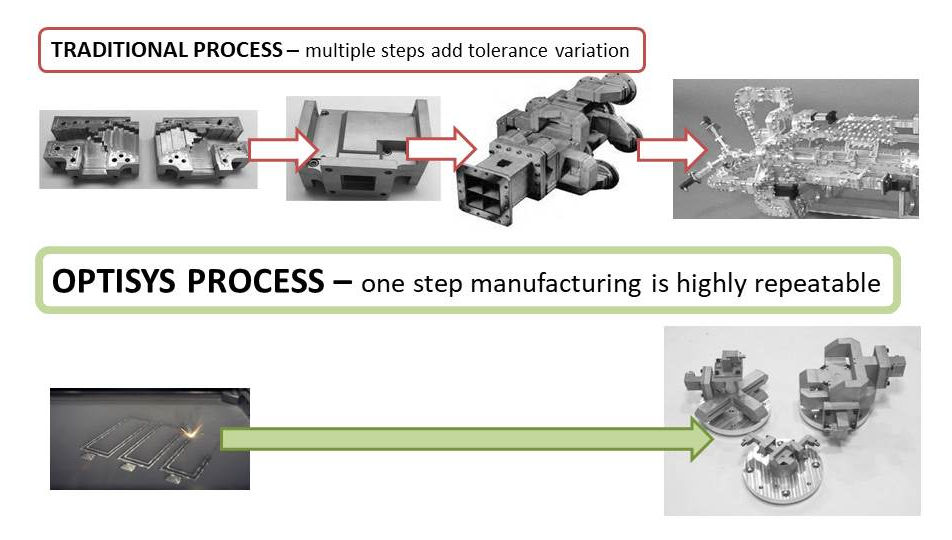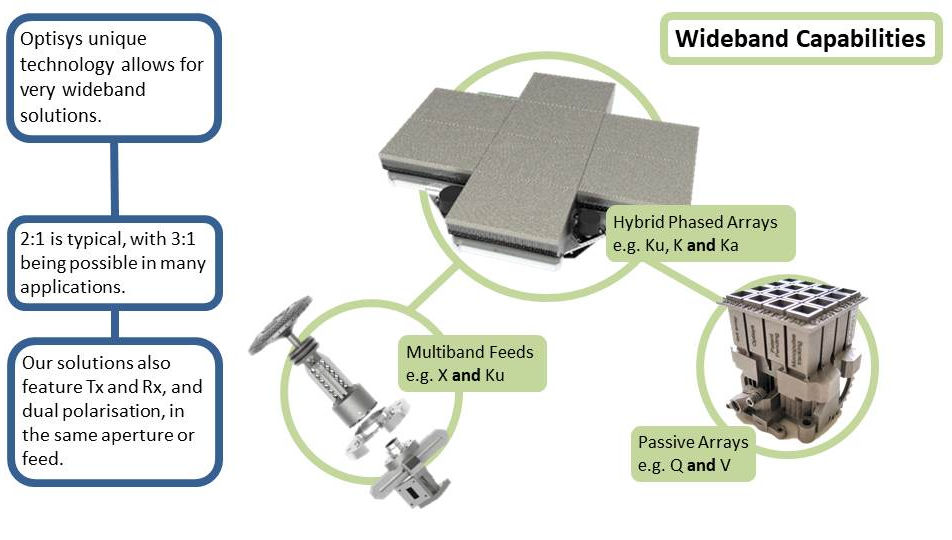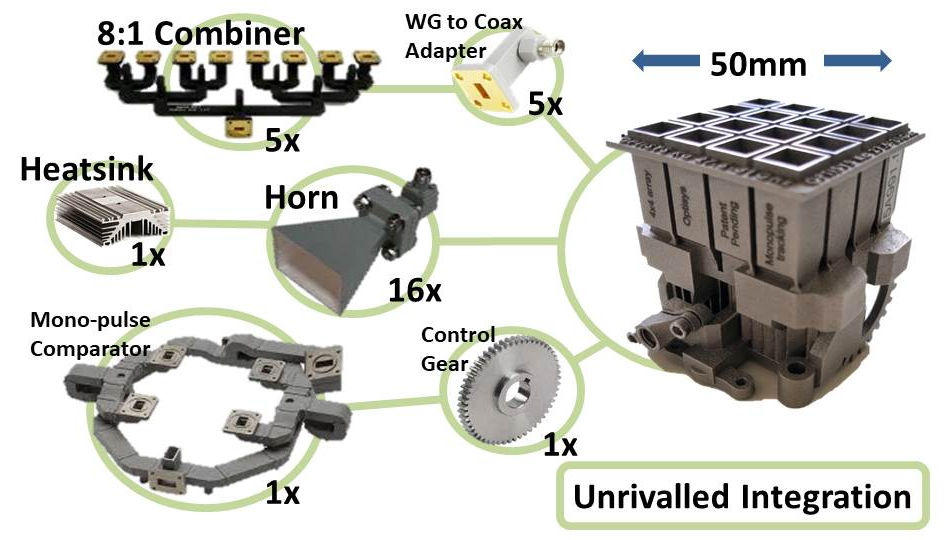U.S. firm Optisys has joined the Satellite Applications Catapult Co-space facility in Harwell, U.K., part of the U.K.’s 40-site Catapult network meant to accelerate the deployment of new technologies through collaboration between research institutes, governments and businesses. There are Catapults for gene therapy, drug discovery, offshore renewable energy, and other potentially impactful technologies.
3D Printed Satellite Parts
3D printing satellite components represents a potential billion-dollar opportunity, that has been underexposed considerably. In this segment in particular, Optisys and Swissto12 have a great deal of potential. Both firms have found a very particular focus area—3D printing RF components—and it’s shocking that they don’t have more competition. These are the parts that allow satellites to communicate with the ground and everywhere else—a very key area in terms of secrecy and performance. Antennas, phased arrays, synthetic aperture radars, filters, and wave guides are key components, all of which Optisys produces.

Those in RF and military aviation seem somewhat obsessed with size, weight, and power (SWaP). That is: if we install this component or system on a rocket or a plane, how much space will it take up, how much of the total allowable weight will it use, how much will it slow down the plane, how much will it actually do for the plane in relationship to how much it will cost for that vehicle? A radar may be awesome, but how much will it reduce the range of an aircraft?
Antennas, phased arrays, synthetic aperture radars, filters, and wave guides can also benefit from having reduced mass. If we assume that it costs $10,000 per kilo to launch a satellite, one could see how any weight reduction via 3D printing would immediately pay for itself. Moreover, this weight savings can be used to make other parts that last longer or put more payload on the satellite.
Antennas could also be made more conformal or feature fewer parts, which would save money and make them easier to build and integrate. This, in turn, could reduce assembly cost, which is very expensive for satellite components. All parts could be integrated together, further cutting assembly costs and mass.

The Satellite Applications Catapult
The Satellite Applications Catapult is meant to establish a complete ecosystem for building satellites. This includes sourcing parts, construction, launching, in-orbit services, and mission support. The group suggests that the site is being developed to meet the needs of the market, with demonstration support, so that organizations can showcase their new technologies and services within the U.K. itself.
“Our unique capability in a number of RF disciplines allows us to be highly useful to many upcoming space missions Having this location central to the UK Space ecosystem enables us to better support those customers,” said Adam Arnold, Vice President of Optisys UK.
“We’re delighted to welcome Optisys to our facilities here in Harwell. Our Co-space is home to a fantastic community of space companies, and is a great example of how collaborative, shared workspaces can benefit organisations both individually and collectively,” stated Nafeesa Dajda, Director of National Capabilities at the Satellite Applications Catapult.
The U.K. lacks the high-tech innovation stimulus structures and research commercialization prowess of Germany, China, and the U.S. It is meant to be a knowledge economy, but doesn’t have the same venture capital (VC) heft, or deep funding for new technologies via national labs, as the U.S. Nor does it have the laser-like focus and national priorities of China. The U.K. has also marooned itself vis a vis European technology funding. A lot of that is up in the air or unlikely to pan out for Britain.

The Catapults are a more sensible idea, given the UK´s self-inflicted isolation. The endeavor is one part “Make Britain Great Again,” another part collaboration, and another part bringing new technologies to market. So, Catapults aren’t really fanciful government projects. Really, they could be pivotal in propelling companies towards commercialization and securing a better place in the technology world for the U.K.

The private space industry looks like an American race, with the only speculation currently focused on which U.S. company will dominate the commercial space sphere. In terms of billions of VC cash, panache, and government investment, the U.S. had the biggest lead and poured in the most cash. It also seems to be building the most infrastructure, giving away the most contracts, providing key regulatory work, and, by far, doing the most marketing. The country also has NASA and a whole bunch of other acronyms with technological needs and edges that are incomparable. I would assume that the James Webb and Hubble telescopes were designed for reading license plates at this point. So, the U.K. and everyone else is playing catch up. And the British method, so far, is to get some of the Americans to set up shop in the U.K.
It is quite a coup for the Catapult to get Optisys to come to Harwell, which has 200 space companies in the region already. This is because the firm is one of the few that has used 3D printing to make reduced mass, highly efficient components that will be needed on everything that flies.
Subscribe to Our Email Newsletter
Stay up-to-date on all the latest news from the 3D printing industry and receive information and offers from third party vendors.
You May Also Like
3D Printing News Briefs, April 13, 2024: Robotics, Orthotics, & Hypersonics
In 3D Printing News Briefs today, we’re focusing first on robotics, as Carnegie Mellon University’s new Robotics Innovation Center will house several community outreach programs, and Ugogo3D is now working...
Rail Giant Alstom Saves $15M with 3D Printing Automation Software 3D Spark
3D Spark has entered into a three-year deal with the rail giant Alstom. Alstom, a transport behemoth with annual revenues of $16 billion, specializes in the manufacture of trains, trams,...
Meltio Expands Global Reach with New Partnerships in the Americas and Europe
Spanish 3D printing manufacturer Meltio has expanded its sales network across the globe. With the addition of three new partners in the United States, Brazil, Argentina, and Italy, Meltio aims...
3D Printing Webinar and Event Roundup: April 7, 2024
Webinars and events in the 3D printing industry are picking back up this week! Sea-Air-Space is coming to Maryland, and SAE International is sponsoring a 3D Systems webinar about 3D...































